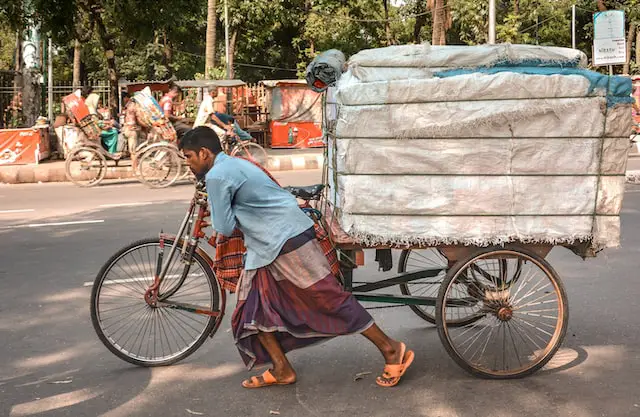A sarong is a long piece of cloth that is wrapped around the waist and worn as a skirt or a dress, primarily by men and women in Southeast Asia and the Pacific Islands. A saree, on the other hand, is a traditional garment worn by women in India, Nepal and Sri Lanka, that is draped around the waist and over one shoulder, typically made of silk or cotton, and worn with a blouse and petticoat.
What is a sarong?
(Photo by Adli Wahid on Unsplash )

A sarong is a long, tube- or rectangular-shaped piece of cloth that is wrapped around the body. It is usually worn as a skirt or dress, but can also be used as a scarf, shawl, or headscarf. Sarongs are commonly made of light cotton or silk fabrics and are often brightly coloured or decorated with patterns.
Sarongs originated in Southeast Asia and are commonly worn by women in Indonesia, Malaysia, Thailand, Burma, Laos, Cambodia, and the Philippines. In Indonesia and Malaysia, sarongs are known as kain batik and sarees are known as selendang. In Thailand, they are called pha sin. Sarongs are also worn by men in some cultures, such as India and Sri Lanka.
What is a saree?
(Photo by Bulbul Ahmed on Unsplash )

A saree, also spelled sari, is a traditional garment worn by women in India, Nepal, Bangladesh and Sri Lanka. It is a long rectangular piece of cloth, typically made of silk or cotton, that is wrapped around the waist and over one shoulder. The saree is worn with a blouse and petticoat, and is draped in a specific way that varies by region. The saree is considered to be one of the oldest and most diverse garments in the world and it is a symbol of cultural heritage, elegance, and femininity in South Asia. It’s worn on various occasions and it’s an important part of their cultural attire.
What is the difference between a sarong and saree?
Sarongs are typically shorter than sarees, and are wrapped around the body rather than draped over one shoulder like a saree. Sarongs are also usually made from lighter fabrics such as cotton or silk, whereas sarees are often made from heavier materials such as wool or brocade.
Another difference is that sarongs are typically worn by men and women in tropical countries, while sarees are more commonly associated with women from India. Sarongs can be decorated with various patterns and colors, but sarees often have more elaborate designs with intricate embroidery or beadwork.
How to wear a sarong
There are many ways to wear a sarong, but the most common way is to wrap it around your waist. You can also wear it as a skirt or dress. If you are wearing it as a skirt or dress, you will need to use a safety pin to keep it in place.
How to wear a saree
The saree is a beautiful and timeless piece of Indian clothing that can be worn in many different ways. Here are some instructions on how to wear a saree:
- First, you will need to choose the right saree for your body type. If you are tall, then you can go for a longer saree. If you are petite, then you can opt for a shorter saree. There are also various other types of sarees available such as half-sarees, dhoti sarees, etc.
- Once you have chosen the right saree, it is time to drape it around your body correctly. The first step is to take the end of the saree and draped it over your left shoulder.
- Then, bring the fabric around your waist and tuck it in at the back or front depending on your preference.
- After that, take the remaining fabric and pleat it neatly before tucking it in at the waist again.
- Once all of that is done, you can adjust the pallu (the part of the saree that covers your chest) accordingly and make sure that it is lying smoothly over your shoulder.
To finish off, accessorize with some ethnic jewelry such as bangles, earrings, and bindi
In what countries do women ware the saree?
The saree is a traditional garment worn by women in India, Pakistan, Sri Lanka, and Bangladesh. It is a long piece of cloth that is wrapped around the body and typically has a decorative border. The saree is usually made from cotton, silk, or georgette fabric.
The saree is typically worn with a blouse and petticoat (a underskirt). The blouse covers the upper body and the petticoat provides support for the lower part of the saree.
There are many different ways to wear a saree, and the style often varies depending on region. In India, women typically wear the saree with the pleats tucked in at the waist, while in Bangladesh and Sri Lanka, women let the pleats hang loose.
The saree is a versatile garment that can be dressed up or down depending on the occasion. For example, a simple cotton saree can be worn for everyday activities such as going to work or running errands. But if you are attending a wedding or other formal event, you may want to wear a more ornate saree made from silk or adorned with embroidery or beads.
What are the types of sarees?
The saree is a traditional garment worn by women in India, Pakistan, Sri Lanka, and Bangladesh. It is a long piece of cloth that is wrapped around the body and over the head. The saree can be made from a variety of fabrics, including silk, cotton, and polyester.
There are many types of sarees, each with its own unique characteristics and traditional origins. Some of the most popular types include:
- Kanjeevaram saree – originated from the city of Kanchipuram in Tamil Nadu and is made of silk and gold or silver zari thread.
- Banarasi saree – from Varanasi, Uttar Pradesh, and is made of silk or cotton and is known for its intricate designs and gold or silver threadwork.
- Chikankari saree – from Lucknow, Uttar Pradesh, and is made of cotton and is known for its delicate, hand-embroidered designs.
- Paithani saree – from Paithan in Maharashtra and is made of silk, known for its vibrant colors and intricate border designs.
- Kota saree – from Kota, Rajasthan and is made of fine cotton and is known for its light weight and geometric patterns.
- Kanchipuram saree – also known as Kanjivaram sarees, are hand-woven silk sarees from Kanchipuram, Tamil Nadu, known for their gold and silver zari, and religious motifs.
- Bhagalpuri sarees – from Bhagalpur, Bihar, are made of Tussar silk, known for their fine texture and elegant drapes.
- Patola sarees – from Patan, Gujarat, are made of silk and are known for their double ikat weave and vibrant colors.
- Sambalpuri sarees – from Sambalpur, Odisha, are known for their traditional Ikat motifs and handloom weaving.
This is not an exhaustive list and there are many other types of sarees that are popular in different regions.
What are the types of Sri Lankan sarees?
- Udarata saree – from the hill country of Sri Lanka, made of cotton and silk, known for their bright colors and traditional patterns.
- Kandyan saree – also known as Osaria saree, from Kandy, Sri Lanka, made of cotton and silk and known for their intricate and colorful designs, especially the borders.
- Puttapaka sarees – from Andhra Pradesh, India, but famous among Sri Lankan Tamils, known for their traditional, intricate and delicate designs.
- Nivi saree – Sri Lankan version of Indian Nivi saree, made of cotton, silk and is known for its beautiful borders and elegant draping styles.
- Mundum Neriyathum – traditional saree from Kerala, India, but worn by Sri Lankan Tamils, known for its simplicity and elegance.
- Fishtail sarees – from southern parts of Sri Lanka, made of cotton and silk, known for their unique shape and traditional designs.
- Matara sarees – from Matara, Sri Lanka, made of cotton, silk and known for their traditional patterns and delicate embroidery.
- Kandy sarees – from the hill country of Sri Lanka, made of cotton and silk, known for their traditional patterns and elegant draping styles.
In what countries do Men ware the sarong?
A sarong is a traditional clothing worn by men in countries such as Indonesia, Malaysia, Singapore, and Brunei. It is usually made of cloth or material that is wrapped around the waist and tied at the front. In some cases, a belt may be used to keep the sarong in place.
The sarong is often seen as a casual piece of clothing but it can also be dressed up for special occasions. For example, in Indonesia, the sarong is sometimes worn during weddings or other formal events. In Malaysia, the sarong is commonly worn by men working in offices or other professional settings.
While the sarong is most commonly associated with Southeast Asian countries, it has also been traditionally worn by men in parts of South Asia such as India and Sri Lanka. In recent years, the sarong has become popular among surfers and other beach-goers in Western countries such as Australia and the United States.
Who wears a sarong?
A sarong is a type of wrapping skirt that is commonly worn by women in Southeast Asia. It is typically made from a brightly colored piece of cloth and is wrapped around the waist, with one end draped over the shoulder. Sarongs are usually worn with a blouse or shirt, and can be either long or short.
Sarees, on the other hand, are a traditional garment worn by women in India. They are usually made from a light cotton or silk fabric, and are draped around the body in a specific way. Sarees are typically worn with a blouse and petticoat, and can vary in length from four to nine yards.
What is the difference between a sarong and pareo?
A sarong is a long, rectangular piece of fabric that can be wrapped around the body in a variety of ways. A pareo is a similar garment, but it is usually triangular in shape and can be worn as a skirt, dress, or scarf. Sarongs are typically made from brightly colored fabrics and are popular beachwear in tropical countries. Pareos are more versatile and can be made from a variety of materials, including cotton, silk, and rayon.
What is the difference between a lungi and a sarong?
A lungi is a traditional Indian garment that is worn around the waist. It is typically made of cotton or other light fabric, and is often brightly colored. A sarong is a similar garment that is worn in Southeast Asia. Sarongs are usually made of heavier fabric, such as silk, and are often decorated with intricate designs.
How does a woman wear a traditional sarong?
A sarong is a piece of fabric that is wrapped around the body. It is usually worn as a skirt or dress, but can also be worn as a top. The fabric is usually brightly colored and patterned. Sarongs are typically made from cotton, silk, or rayon.
To wear a sarong as a skirt or dress, first fold the fabric in half lengthwise. Then, tie the sarong around your waist so that the fold is at the back. Next, bring the two ends of the sarong up over your shoulders and tie them together at the front. Finally, adjust the folds of the fabric to create a flattering silhouette.
Sarongs can also be worn as tops. To do this, simply tie the sarong around your chest so that it covers your breasts. You can adjust the amount of coverage by adjusting how tight you tie the sarong and where you place it on your body.
Why is it called a sari?
The word “sari” comes from the Sanskrit word साडि (sāṭi), which means “strip of cloth”. It is thought that the first saris were simply lengths of cloth that were draped around the body in a variety of ways. Over time, the sari developed into the more standardized garment we now recognize.
What do you wear under a saree?
There are a few different options for what you can wear under a saree. The most common and traditional option is to wear a petticoat. A petticoat is a skirt that is worn under the saree and helps to give it shape. Other options include wearing a pair of shorts or leggings under your saree. This can be a good option if you are worried about the saree slipping or if you are not used to wearing a petticoat. Whatever you choose to wear under your saree, make sure that it is comfortable and that it does not show through the saree.
Is saree casual or formal?
The saree is a traditional Indian garment that is typically worn by women on special occasions. The saree can be considered both casual and formal, depending on the style and fabric. A saree made of a cotton or other natural fiber is more likely to be considered casual, while a saree made of a silk or other luxurious fabric is more likely to be considered formal.
What are the benefits of wearing saree?
- A saree is a versatile garment that can be worn in a variety of ways.
- A saree can be worn as both casual and formal attire.
- A saree is a great way to show off your curves.
- A saree is a great way to add color and style to your wardrobe.
Featured Image By – Photo by Urvi Kotasthane on Unsplash








